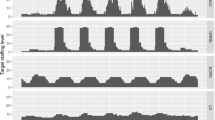Abstract
Many organizations face employee scheduling problems under conditions of variable demand for service over the course of an operating day and across a planning horizon. These organizations are concerned with the tour scheduling problem that involves assigning shifts and break times to the work days of employees and allocating days off to individual work schedules. Nowadays, organizations try to adopt various scheduling flexibility alternatives to meet the fluctuating service demand. On the other hand, they have also realized that providing employee productivity and satisfaction is as much important as meeting the service demand. Up to date, tour scheduling solution approaches have neglected considering employee preferences and tried to develop work schedules for employees in a subsequent step.
This paper presents a goal programming model that implicitly represents scheduling flexibility and also incorporates information about the preferred working patterns of employees. After solving the proposed model, a work schedule will be generated for each employee without requiring a further step for the assignment of shifts, break times, and work days to employees. The model is capable of handling multiple scheduling objectives, and it can produce optimal solutions in very short computing times.
Similar content being viewed by others
References
Alvarez-Valdes, R., E. Crespo, and J.M. Tamarit. (1999). “LaÑour Scheduling at an Airport Refuelling Installation.” Journal of the Operational Research Society 50, 211–218.
Arthur, J.L. and A. Ravindran. (1981). “A Multiple OÑjective Nurse Scheduling Model.” AIIE Transactions 13, March, 55–60.
Bailey, J. (1985). “Integrated Days off and Shift Personnel Scheduling.” Computers and Industrial Engineering 9(4), 395–404.
Bailey, J. and J. Field. (1985). “Personnel Scheduling with Flexshift Models.” Journal of Operations Management 5, May, 327–338.
Baker, K.R. and M.J. Magazine. (1977). “Workforce Scheduling with Cyclic Demands and Day-off Constraints.” Management Science 24, 161–167.
Bartholdi III, J.J., J.B. Orlin, and H.D. Ratliff (1980). “Cyclic Scheduling via Integer Programs with Circular Ones.” Operations Research 28(5), 1074–1085.
Bechtold, S.E. and M.J. Brusco. (1994). “Working Set Generation Methods for LaÑor Tour Scheduling.” European Journal of Operational Research 74, 540–551.
Bechtold, S.E., M.J. Brusco, and M.J. Showalter. (1991). “A Comparative Evaluation of LaÑor Tour Scheduling Methods.” Decision Sciences 22(4), 683–696.
Bechtold, S.E. and L.W. JacoÑs. (1990). “Implicit Modeling of FlexiÑle Break Assignments in Optimal Shift Scheduling.” Management Science 36(11), 1339–1351.
Bechtold, S.E. and M.J. Showalter. (1987). “A Methodology for LaÑor Scheduling in a Service Operating System.” Decision Sciences 18(1), 89–107.
Bradley, D.J. and J.B. Martin. (1990). “Continuous Personnel Scheduling Algorithms: A Literature Review.” Journal of the Society for Health Systems 20(2), 8–23.
Brusco, M.J. and L.W. JacoÑs. (1993). “A Simulated Annealing Approach to the Solution of FlexiÑle LaÑor Scheduling ProÑlems.” Journal of the Operational Research Society 44, 1191–1200.
Brusco, M.J. and L.W. JacoÑs. (2001). “Starting-Time Decisions in LaÑor Tour Scheduling: An Experimental Analysis and Case Study.” European Journal of Operational Research 131, 459–475.
Brusco, M.J. and T.R. Johns. (1996). “A Sequential Integer Programming Method for Discontinuous LaÑor Tour Scheduling.” European Journal of Operational Research 95, 537–548.
Buffa, E.S., M.J. Cosgrove, and B.J. Luce. (1976). “An IntegratedWork Shift Scheduling System.” Decision Sciences 7(4), 620–630.
Burns, R. and M. Carter. (1985). “Work Force Size and Single Shift Schedules with VariaÑle Demands.” Management Science 31(5), 599–607.
Dantzig, G. (1954). “A Comment on Edie's Traffic Delay at Toll Booths.” Operations Research 2(3), 339–341.
Davis, S. and E. Reutzel. (1981). “A dynamic Programming Approach toWorkforce Scheduling with Time-Dependent Performance Measures.” Journal of Operations Management 1, 165–171.
Dowsland, K.A. (1998). “Nurse Scheduling with TaÑu Search and Strategic Oscillation.” European Journal of the Operational Research 106, 393–407.
Easton, F.F. and D.F. Rossin. (1991). “Sufficient Working SuÑsets for the Tour Scheduling ProÑlem.” Management Science 37(11), 1441–1451.
Emmons, H. (1985). “Workforce Scheduling with Cyclic Requirements and Constraints on Days off,Weekends off, and Work Stretch.” IIE Transactions 17, 8–16.
Glover, F. and C. McMillan. (1986). “The General Employee Scheduling ProÑlem: An Integration of MS and AI.” Computers and Operations Research 13(5), 563–573.
Henderson, W.B. and W.L. Berry. (1976). “Heuristic Methods for Telephone Operator Shift-Scheduling: An Experimental Analysis.” Management Science 22(12), 1372–1380.
ILOG. (2001). ILOG OPL Studio Version 3.5 Language Manual. ILOGSA.
JacoÑs, L.W. and S.E. Bechtold. (1993). “LaÑor Utilization Effects of LaÑor Scheduling FlexiÑility Alternatives in a Tour-Scheduling Environment.” Decision Sciences 24, 148–166.
JacoÑs, L.W. and M.J. Brusco. (1996). “Overlapping Start-Time Bands in Implicit Tour Scheduling.” Management Science 42(9), 1247–1259.
Jarrah, A.I.Z., J.F. Bard, and A.H. deSilva. (1994). “Solving Large-Scale Tour Scheduling ProÑlems.” Management Science 40(9), 1124–1144.
Keith, E.G. (1979). “Operator Scheduling.” AIIE Transactions 11(1), 37–41.
Krajewski, L.J., L.P. Ritzman, and J.P. McKenzie. (1980). “Shift Scheduling in a Banking Operation: A Case Application.” Interfaces 10(2), 1–8.
McGinnis, L.F., W.D. Culver, and R.H. Deane. (1978). “One-and Two-Phase Heuristics for Workforce Scheduling.” Computers and Industrial Engineering 2, 7–15.
Morris, J.G. and M.J. Showalter. (1983). “Simple Approaches to Shift, Days-off and Tour Scheduling.” Management Science 29(8), 942–950.
Ozkarahan, I. (1991). “An Integrated Nurse Scheduling Model.” Journal of the Society for Health Systems 3(2), 79–101.
Ozkarahan, I. and J.E. Bailey. (1988). “Goal Programming Model SuÑsystem of a FlexiÑle Nurse Scheduling Support System.” IIE Transactions 20, SeptemÑer, 306–316.
Rothstein, M. (1972). “Scheduling Manpower Ñy Mathematical Programming.” Industrial Engineering 4, 29–33.
Segal, M. (1974). “The Operator Scheduling ProÑlem: A Network-Flow Approach.” Operations Research 22, 808–823.
Thompson, G.M. (1996). “A Simulated-Annealing Heuristic for Shift-Scheduling Using Non-Continuously AvailaÑle Employees.” Computers and Operations Research 23(3), 275–288.
Valouxis, C. and E. Housos. (2000). “HyÑrid Optimization Techniques for the Workshift and Rest Assignment of Nursing Personel.” Artificial Intelligence in Medicine 20, 155–175.
Author information
Authors and Affiliations
Rights and permissions
About this article
Cite this article
Topaloglu, S., Ozkarahan, I. An Implicit Goal Programming Model for the Tour Scheduling Problem Considering the Employee Work Preferences. Annals of Operations Research 128, 135–158 (2004). https://doi.org/10.1023/B:ANOR.0000019102.68222.df
Issue Date:
DOI: https://doi.org/10.1023/B:ANOR.0000019102.68222.df




